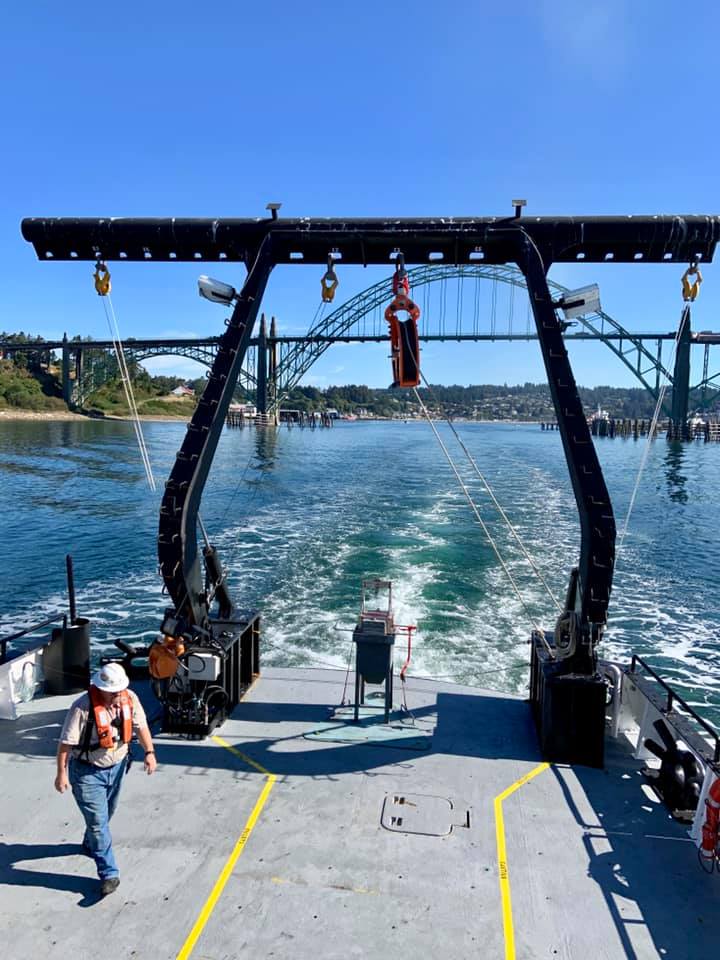This post is part of a series chronicling the September 12-15, 2019 research cruise on board the R/V Oceanus, Oregon State University’s largest research vessel. This cruise was funded by Oregon Legislative funds through the Oceangoing Research Vessel Program. Coordination and additional support was provided by Oregon Sea Grant and the Oregon Coast STEM Hub.
Follow the adventures of the students, educators, and researchers who are on board engaging in #STEMatSea.
By Noah Goodwin-Rice
It has now been a few days since we returned from our four-day cruise on the R/V Oceanus, so I have had ample time to reflect on my experience. More than anything else, I believe that this opportunity has helped show me the value in demonstrating patience while conducting work in the field.
In particular, this concept was impressed on me by Dr. Leigh Torres and her Ph.D. student Dawn Barlow while conducting cetacean surveys from the ship. At times during our surveys, the vessel would proceed for hours across the ocean without the slightest indication of any whales. Eventually, we would sight an individual off on the horizon; then, within the span of perhaps 30 minutes, we would find our ship surrounded on all sides by so many humpbacks that it became difficult to keep track of them all! I soon realized that, inevitably, the monotonous stretches of empty ocean we traversed would reward us with the sight of the animals we sought so much. And the animals were always a treat to see; I truly enjoyed the chance to observe the whales we saw each day.



Of course, our time during the cruise wasn’t solely devoted to whale surveys. There were other lessons in the value of patience each time we took samples of the ocean floor, gathering information on benthic ecology. To take samples of the ocean floor at various locations on the cruise, we used a winch at the stern of the ship to lower a box coring device that would return a scoop of sediment to the surface.

Then, after each sample was recovered on the ship’s deck, our job became the rather tedious work of picking out any small invertebrates that were carried up along with the sediment. This prepared the biological contents to be analyzed later back on shore.
It could be monotonous work, but I actually found the job to be incredibly fulfilling. Each sample became almost like a scavenger hunt, and it was fun to come across the many different unique species of annelids, arthropods, cnidarians, echinoderms, and molluscs. As I changed out of my hard hat and waterproof gear at the end of each sampling session, it felt great to have accomplished something that would further our understanding of the ocean floor – even if each sample demanded a significant investment of time to process.
Looking back on my experiences this past week on the R/V Oceanus, I feel exceedingly grateful to have been able to participate in this special opportunity. One reason I was so keen to be a part of this research cruise is because I am currently in the process of considering which paths to pursue in my future. My experience these past several days at sea has helped me realize that this is a line of work that I might be interested in continuing, and this will likely play an important role in my ultimate choices in the coming months.

Noah Goodwin-Rice attends Newport High School, and has spent two summers working as an youth interpreter at Yaquina Head Outstanding Natural Area. He is also a youth volunteer at the Oregon Coast Aquarium, and a member of the Aquarium’s “Nerdi Nautili” National Ocean Sciences Bowl team.







































